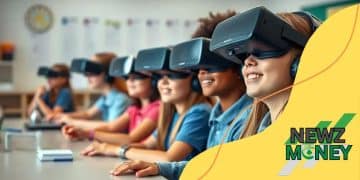How AR is being used for hands-on learning experiences

Augmented Reality (AR) is enhancing hands-on learning experiences by increasing student engagement, improving retention, and providing personalized, interactive educational opportunities, despite challenges like technology access and the need for teacher training.
How AR is being used for hands-on learning experiences is transforming the way students engage with educational content. Imagine a classroom where anatomy comes alive or history is experienced first-hand! Curious how it works? Let’s dive in.
Understanding augmented reality in education
Understanding augmented reality in education is essential as technology evolves. This innovative approach enhances the learning experience by blending digital elements with the physical world, making lessons more engaging. With AR, students can visualize complex ideas, which helps to improve retention and understanding.
How Augmented Reality Works
Augmented reality uses technology to overlay digital information onto the real world. This is done through devices like smartphones and tablets. As students interact with these devices, they discover new layers of information and experience education in immersive ways. Imagine a history lesson where students can explore ancient civilizations virtually!
Key Benefits of Augmented Reality
- Interactive learning: AR makes learning fun and engaging, capturing students’ attention.
- Visual education: It helps students visualize abstract concepts and understand them better.
- Enhanced collaboration: AR encourages teamwork and communication among students.
- Real-world applications: Learning becomes relevant as students relate to their environments.
Furthermore, with AR, a simple science class can transform into an adventure. Students can conduct virtual experiments that would be impossible in a traditional classroom. This hands-on experience stimulates curiosity and fosters a passion for learning. As technology continues to advance, more educational institutions are incorporating AR into their curricula.
Teachers are now able to create interactive lessons that captivate their students. By integrating AR, they can cater to various learning styles, ensuring that everyone benefits from the lesson. The applications are broad and varied, from learning languages to mastering mathematics.
As we delve deeper into augmented reality in education, we can anticipate numerous positive impacts on student performance. Early adopters of AR technology in the classroom have noted significant improvements in student engagement and participation. This technology is paving the way for a future where education is more connected to the real world.
Benefits of hands-on learning with AR
Benefits of hands-on learning with AR are becoming increasingly clear as more educators adopt innovative teaching methods. Integrating augmented reality (AR) into the learning process not only makes education more interactive but also enhances student engagement.
Increased Engagement
One significant benefit of using AR is increased engagement. Students are more likely to participate in lessons that involve interactive visuals. When lessons come to life through AR, students can connect with the material on a deeper level.
Improved Retention
Hands-on learning with AR helps improve information retention. Research shows that when learners interact with content, they are better able to remember it. AR enables students to explore concepts actively rather than passively receiving information. This involvement leads to a stronger grasp of challenging topics.
- Real-world applications: Students see how knowledge applies in real life.
- Visual learning: Complex ideas are visualized, making them easier to understand.
- Collaborative experiences: Working in teams fosters communication and problem-solving skills.
Moreover, AR promotes critical thinking and creativity. As students use AR tools, they are challenged to think analytically and devise solutions to problems. This process prepares them for real-world scenarios where these skills are essential. Collaborating in this environment cultivates teamwork and enhances social skills.
Additionally, teachers can tailor lessons to fit individual student needs, allowing for personalized learning experiences. By using AR, educators can cater to various learning styles, ensuring no student is left behind. This adaptability is crucial in today’s diverse classrooms.
The hands-on approach that AR facilitates creates memorable educational experiences. When students are actively involved in their learning, their motivation increases. This not only benefits their academic performance but also their overall love for learning.
Practical applications of AR in classrooms

Practical applications of AR in classrooms showcase how this technology can transform traditional teaching methods. By incorporating augmented reality, educators create immersive learning environments that captivate students’ attention and enhance their understanding of complex subjects.
Interactive Lesson Plans
One practical application is the use of AR to design interactive lesson plans. Teachers can create visual aids that overlay digital information onto real-world objects. For instance, in a biology class, students can view 3D models of cells or organs, allowing them to explore structures in a way that textbooks cannot provide.
Field Trips from the Classroom
AR technology also allows students to take virtual field trips without leaving their classrooms. This capability enriches the learning experience, as students can explore historical landmarks or natural wonders. With just a tablet or smartphone, they can interact with interactive maps and simulations, bringing lessons to life.
- Science experiments: Conduct safe and controlled experiments through AR simulations.
- Art history: Visualize classic artworks and learn about their contexts.
- Language learning: Enhance vocabulary lessons with AR objects that correspond to new words.
Furthermore, using AR in math lessons can help students visualize geometric shapes and complex equations. They can manipulate these shapes in real-time, enhancing their comprehension of spatial relationships. This hands-on experience solidifies their learning and builds confidence in their math skills.
Additionally, AR promotes critical thinking and creativity. Students can solve problems collaboratively by engaging with AR content that requires them to think outside the box. This approach encourages discussions and fosters a deeper understanding of the material. As they work together on AR assignments, teamwork and communication skills grow stronger.
By utilizing AR technology, teachers can customize their instruction to meet diverse learning needs. This differentiation is vital for promoting an inclusive classroom environment where every student can thrive. The flexibility offered by AR also allows students to progress at their own pace, ensuring they fully grasp the concepts before moving on.
Challenges educators face with AR
Challenges educators face with AR are significant and need to be addressed for successful implementation. While augmented reality offers exciting opportunities, it also presents hurdles that can affect its effectiveness in the classroom. Understanding these challenges is crucial for teachers and administrators alike.
Technological Barriers
One major challenge is the availability of technology. Many schools lack the necessary devices, such as tablets or AR glasses, to fully implement these programs. Additionally, not all educational institutions have the strong internet connectivity required for seamless AR experiences. This disparity can create a gap in learning opportunities.
Teacher Training
Another significant obstacle is the lack of training for educators. Many teachers are not familiar with AR tools and may feel overwhelmed by new technology. It’s essential for schools to provide adequate training to ensure that teachers are comfortable using AR in their lessons. This includes understanding both the technology and how to integrate it into their curriculum effectively.
- Adapting to changing curricula: Teachers may struggle to adapt their lesson plans to include AR content.
- Catering to different learning styles: Ensuring that AR meets the diverse needs of all students can be complex.
- Managing classroom dynamics: AR can sometimes distract students rather than engage them.
Moreover, providing access to AR resources can be challenging. Many high-quality AR applications require subscriptions or licensing fees, which might not fit into school budgets. This limitation can hinder the ability to explore the full potential of AR in education.
Additionally, educators must consider the integration of AR into existing standards and assessments. Aligning augmented reality projects with state and national standards is key to gaining support from school districts. This alignment can be complex and time-consuming, which may deter teachers from using AR technologies.
Finally, there are concerns about screen time and its effects on students. Balancing the use of technology with traditional learning methods is an ongoing debate. Educators need to be mindful of how much AR content is introduced to ensure that students have a well-rounded educational experience.
Future trends of AR in hands-on learning
Future trends of AR in hands-on learning promise exciting advancements in educational settings. As technology continues to evolve, the integration of augmented reality is expected to grow, greatly impacting how students learn. This innovation will lead to more engaging and interactive educational experiences.
Enhanced Customization
One key trend is the enhanced customization of learning experiences. Future AR applications will allow teachers to tailor content to meet the individual needs of students. This means that lessons can be more personalized, catering to different learning styles and paces.
Increased Accessibility
Another important trend is the increased accessibility of AR tools. As technology becomes more affordable, more schools will adopt AR solutions. This shift will help bridge the digital divide, allowing all students to benefit from immersive learning experiences.
- Use of AI: Artificial intelligence will play a significant role in shaping AR content, making it more interactive and adaptive to students’ needs.
- Mobile learning: With smartphones more prevalent, students can access AR learning materials whenever and wherever they need.
- Collaborative learning: Future AR systems will facilitate real-time collaboration, enabling students to work together on projects from different locations.
Moreover, advancements in virtual reality (VR) technology may integrate seamlessly with AR, creating hybrid experiences. This combination can offer students fully immersive educational experiences that simulate real-world situations. For example, students could conduct virtual science experiments or explore historical events in 3D environments, making lessons more impactful.
As AR technology advances, creating more realistic simulations will also become possible. Enhanced graphics and improved tracking systems will allow for more lifelike interactions. This realism can significantly boost student engagement and motivation, as they see their lessons come to life.
Finally, the integration of augmented reality with data analytics will provide educators with insights into student performance. By analyzing how students interact with AR content, teachers can adjust their instruction to better meet student needs. This feedback loop will foster a more effective learning environment.
FAQ – Frequently Asked Questions about Augmented Reality in Hands-On Learning
What is augmented reality (AR) in education?
AR in education is a technology that overlays digital information onto the real world, enhancing learning experiences through interactive and immersive content.
How can AR improve student engagement?
AR can make lessons more interactive and fun, capturing students’ attention and motivating them to participate actively in their learning.
What challenges do teachers face when using AR?
Teachers may encounter technological barriers, such as lack of equipment, and need training to effectively integrate AR into their curriculum.
What are some future trends of AR in education?
Future trends include personalized learning experiences, increased accessibility, and enhanced integration with other technologies like artificial intelligence.





